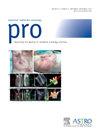Implantable Rectal Spacers in Prostate Cancer Radiation Therapy: A Systematic Review
IF 3.5
3区 医学
Q2 ONCOLOGY
引用次数: 0
Abstract
Purpose
This systematic review provides an overview of the available literature regarding the efficacy and safety of implantable rectal spacers (IRSs) in reducing rectal dose and gastrointestinal toxicity during prostate cancer radiation therapy.
Methods and Materials
A comprehensive literature search was conducted in December 2024. Results included prospective research in humans and were limited to the English language. The 30 included studies, all published between 2007 and 2024, were randomized controlled trials or clinical trials that focused on adverse events, rectal dose reduction, gastrointestinal toxicity, or bowel quality of life. Next, IRS implantation technique, safety, and spacing distance were assessed.
Results
Randomized controlled trial data were available for hydrogel, hyaluronic acid, and rectal balloon implant spacers, whereas only one pilot study is available for human collagen. Prospective clinical research on IRS in brachytherapy is limited. One centimeter of spacing between the rectum and prostate sufficed to spare the rectum, the primary dose-limiting organ. Findings indicate a favorable safety profile, with an overall complication rate of 0,96% when using hydrogel spacers. There was no grade 4 to 5 gastrointestinal toxicity reported in clinical trials. The use of an IRS was associated with improved long-term bowel quality of life.
Conclusions
The integration of IRS into clinical practice offers the potential to enhance the therapeutic landscape for patients with prostate cancer. However, its use should be guided by careful consideration of individual patient needs to determine those who benefit most from the IRS because not all patients may benefit equally.
植入式直肠间隔器(IRS)在前列腺癌放疗中的应用综述。
目的:本系统综述了关于植入式直肠间隔剂(IRS)在前列腺癌(PC)放疗(RT)期间降低直肠剂量和胃肠道(GI)毒性的有效性和安全性的现有文献。方法与材料:于2024年12月进行全面的文献检索。结果包括对人类的前瞻性研究,并且仅限于英语语言。纳入的30项研究均发表于2007年至2024年间,均为随机对照试验(rct)或临床试验,重点关注不良事件(ae)、直肠剂量减少、胃肠道毒性或肠道生活质量(QOL)。其次,评估IRS植入技术、安全性及间距。结果:水凝胶(HG)、透明质酸(HA)和直肠球囊植入物(RBI)间隔物的RCT数据可用,而HC只有一项试点研究可用。IRS在近距离放射治疗中的前瞻性临床研究有限。直肠和前列腺之间一厘米的间距足以使直肠——主要的剂量限制器官——免受影响。研究结果表明,使用水凝胶(HG)垫片具有良好的安全性,总并发症发生率为0.96%。在临床试验中没有4-5级胃肠道毒性的报道。IRS的使用与长期肠道生活质量的改善有关。结论:将IRS整合到临床实践中有可能提高PC患者的治疗前景。然而,它的使用应仔细考虑个别患者的需要,以确定哪些人从IRS获益最多,因为不是所有患者都能同样受益。
本文章由计算机程序翻译,如有差异,请以英文原文为准。
求助全文
约1分钟内获得全文
求助全文
来源期刊

Practical Radiation Oncology
Medicine-Radiology, Nuclear Medicine and Imaging
CiteScore
5.20
自引率
6.10%
发文量
177
审稿时长
34 days
期刊介绍:
The overarching mission of Practical Radiation Oncology is to improve the quality of radiation oncology practice. PRO''s purpose is to document the state of current practice, providing background for those in training and continuing education for practitioners, through discussion and illustration of new techniques, evaluation of current practices, and publication of case reports. PRO strives to provide its readers content that emphasizes knowledge "with a purpose." The content of PRO includes:
Original articles focusing on patient safety, quality measurement, or quality improvement initiatives
Original articles focusing on imaging, contouring, target delineation, simulation, treatment planning, immobilization, organ motion, and other practical issues
ASTRO guidelines, position papers, and consensus statements
Essays that highlight enriching personal experiences in caring for cancer patients and their families.
 求助内容:
求助内容: 应助结果提醒方式:
应助结果提醒方式:


